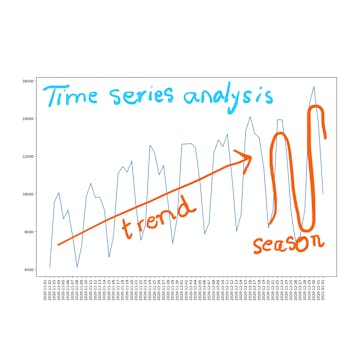
By the end of this project, you will learn how to perform the entire time series analysis workflow for the daily COVID-19 deaths. This workflow includes the following steps: how to examine time series data, prepare the data for analysis, train different models and test their performance, and finally use the models to forecast into the future. You will learn how to visualize data using the matplotlib library, extract features from a time series data set, and perform data splitting and normalization. You will create time series analysis models using the python programming language. You will create and train four time series models:...
Read more
Good to know
Save this course
Reviews summary
Time series analysis for covid-19
Activities
Time Series Analysis Course Materials
Show steps
Compiling and reviewing your course materials will help you stay organized and focused throughout the course.
Show steps
-
Download and save all course materials.
-
Create a study schedule.
Python Programming
Show steps
Refreshing your Python programming skills will help you better understand the code examples and assignments in this course.
Browse courses on
Python Programming
Show steps
-
Review the basics of Python syntax and data structures.
-
Practice writing simple Python programs.
Time Series Analysis Study Group
Show steps
Participating in a study group is a great way to collaborate with other students, discuss course concepts, and reinforce your learning.
Show steps
-
Find a few classmates to form a study group.
-
Meet regularly to discuss course topics.
-
Work together on assignments and projects.
One other activity
Expand to see all activities and additional details
Show all four activities
Time Series Data Visualization Using Matplotlib
Show steps
Visualizing time series data will help you analyze the trends, patterns, and seasonality of the data. This is a critical skill for understanding and forecasting time series data.
Show steps
-
Explore the Matplotlib library for time series visualization.
-
Plot different types of time series data such as line plots, scatter plots, and bar plots.
-
Customize the appearance of your plots by changing the colors, markers, and labels.
Time Series Analysis Course Materials
Show steps
Compiling and reviewing your course materials will help you stay organized and focused throughout the course.
Show steps
- Download and save all course materials.
- Create a study schedule.
Python Programming
Show steps
Refreshing your Python programming skills will help you better understand the code examples and assignments in this course.
Browse courses on
Python Programming
Show steps
- Review the basics of Python syntax and data structures.
- Practice writing simple Python programs.
Time Series Analysis Study Group
Show steps
Participating in a study group is a great way to collaborate with other students, discuss course concepts, and reinforce your learning.
Show steps
- Find a few classmates to form a study group.
- Meet regularly to discuss course topics.
- Work together on assignments and projects.
Time Series Data Visualization Using Matplotlib
Show steps
Visualizing time series data will help you analyze the trends, patterns, and seasonality of the data. This is a critical skill for understanding and forecasting time series data.
Show steps
- Explore the Matplotlib library for time series visualization.
- Plot different types of time series data such as line plots, scatter plots, and bar plots.
- Customize the appearance of your plots by changing the colors, markers, and labels.
Career center
Data Analyst
Machine Learning Engineer
Data Scientist
Statistician
Financial Analyst
Actuary
Epidemiologist
Biostatistician
Market Researcher
Operations Research Analyst
Risk Manager
Business Analyst
Data Engineer
Software Engineer
Web Developer
Reading list
Share
Similar courses
OpenCourser helps millions of learners each year. People visit us to learn workspace skills, ace their exams, and nurture their curiosity.
Our extensive catalog contains over 50,000 courses and twice as many books. Browse by search, by topic, or even by career interests. We'll match you to the right resources quickly.
Find this site helpful? Tell a friend about us.
We're supported by our community of learners. When you purchase or subscribe to courses and programs or purchase books, we may earn a commission from our partners.
Your purchases help us maintain our catalog and keep our servers humming without ads.
Thank you for supporting OpenCourser.



